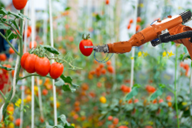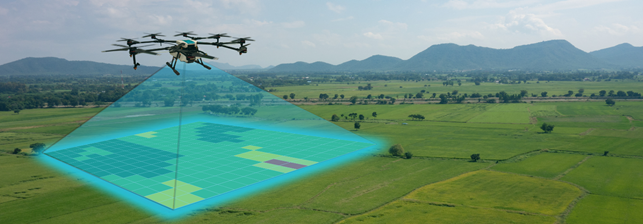How can SDGs help in Narrowing the Digital Transformation Gap in Agri-food Systems?
Prelude:
The advent of digital technologies in the agri-food industry has played an essential role in augmenting the value-add for its stakeholders and transforming the agriculture industry in unprecedented ways before the digital age. Perhaps this transformation is best manifested in Precision Agriculture, a farming management system that combines artificial intelligence, sensors, GPS, satellite imaging, and other specialized hardware to provide higher degrees of precision, predictability, and analytics that enable farmers to better plan their crops farming activities according to weather patterns, save on water consumption and pesticide use, assess soil and plants health, plan and manage labor activity in large swaths of agricultural land more productively, and spot harmful pests, to name a few of the advantages of this management system (1).

Farmers now use robots in harvesting, plant spraying, automatic, and livestock/ aquaculture feeding, thereby freeing field workers to do more value-adding work. Drones are now being used to fire plant seeds into forests, helping plant trees 150 times faster than traditional methods, thereby increasing the speed and scale of forestry augmentation (2).
Digital Agri-Tech: good for business and the environment, what about the people producing our food?
While these technological advancements are significantly beneficial for the economic and environmental sustainability of the agri-food system, they are not equitably accessible to a sizable class of stakeholders in the system, especially in rural areas and the global south; notably less tech-savvy older farmers whose global average age is 60 (3), and resource-limited smallholder farmers that produce 60% to 80% of food in developing countries (4) and 1/3 of global food production (5).
Future-proofing the agri-food system workers’ livelihoods is not just the right thing to do for a workforce responsible for feeding the world but is also essential to stabilizing the socio-economic and political fabrics of many economies around the globe, especially in agriculture-reliant economies. In most cases, the capacity of the abovementioned group of stakeholders cannot easily accommodate the procurement and application of these technologies. In addition, as technology evolves to replace work traditionally done by humans, mainly manual and routine jobs, it creates a challenge that jeopardizes the livelihood of millions of handymen and women working in the agri-food sector and their ability to provide for their families (6). These consequences are unsustainable and are in no way acceptable.
 For digital transformation to achieve real and sustainable change, it needs to be inclusive of all stakeholders involved in its value chain. Such undertaking is challenging, to say the least, but attainable if indicators of SDG 17 (partnerships for the goals), SDG 4 (ensure inclusive and equitable education and promote lifelong learning opportunities for all), and SDG 8 (promote sustained, inclusive and sustained economic growth, full and productive employment and decent work for all) were converged and activated in a systematic way to address gaps in the enablement and adoption of digital technologies for all agri-food system stakeholders who need them, as well as ensuring that no single group in the system is left behind.
For digital transformation to achieve real and sustainable change, it needs to be inclusive of all stakeholders involved in its value chain. Such undertaking is challenging, to say the least, but attainable if indicators of SDG 17 (partnerships for the goals), SDG 4 (ensure inclusive and equitable education and promote lifelong learning opportunities for all), and SDG 8 (promote sustained, inclusive and sustained economic growth, full and productive employment and decent work for all) were converged and activated in a systematic way to address gaps in the enablement and adoption of digital technologies for all agri-food system stakeholders who need them, as well as ensuring that no single group in the system is left behind.
So how can SDGs 17, 4, and 8 narrow this gap?
 SDG 17 calls for multi-stakeholder partnerships to advance sustainable development, and in the very spirit of this ethos, many public and private entities have collaborated to develop several good practice principles and initiatives to address complex challenges and opportunities in the Food & Beverage industry, like the Consumer Goods Forum which showcased “significant leadership in aligning the industry with the pursuit of the Sustainable Development Goals” (7)
SDG 17 calls for multi-stakeholder partnerships to advance sustainable development, and in the very spirit of this ethos, many public and private entities have collaborated to develop several good practice principles and initiatives to address complex challenges and opportunities in the Food & Beverage industry, like the Consumer Goods Forum which showcased “significant leadership in aligning the industry with the pursuit of the Sustainable Development Goals” (7)
Such partnership may extend to form a global Center of Excellence for digital agri-food systems as an umbrella that guides the development of frameworks, programs, R&D, provide advisory services, assist in availing basic infrastructure, and enable best-practice sharing of latest digital developments in the industry. Supported by blended financing and strictly governed by applicable ESG frameworks, this center can create several digital hubs worldwide to pilot and customize local and regional programs addressing geo-specific challenges and opportunities. These hubs could also extend their outreach to tech startups solving problems for the agri-food industry through grants, testing grounds, and ideation labs.
 SDG 4 Drawing on the abovementioned center of excellence, capacity development programs can be formed to conduct digital skills gap analysis and develop fit-for-purpose regional educational programs, with rigorous ROI assessment, on emerging technologies deployment in agriculture. The democratization of tech and digital technologies know-how amongst agri-food system workers is vital for the social sustainability of the sector as it helps in securing their employment prospects against the drawbacks of rising digitalization and automation waves, as well as in bridging the digital divide that currently exists amid the sector’s workforce.
SDG 4 Drawing on the abovementioned center of excellence, capacity development programs can be formed to conduct digital skills gap analysis and develop fit-for-purpose regional educational programs, with rigorous ROI assessment, on emerging technologies deployment in agriculture. The democratization of tech and digital technologies know-how amongst agri-food system workers is vital for the social sustainability of the sector as it helps in securing their employment prospects against the drawbacks of rising digitalization and automation waves, as well as in bridging the digital divide that currently exists amid the sector’s workforce.
 SDG 8 By upgrading and repurposing their skillset, the agri-food workers shall be more resilient, versatile, and in a much better position to explore different tech-related opportunities in the sector that provide them with decent employment and better livelihoods. The research on benefits gained by farmers practicing traditional agriculture and those engaged in tech-enabled farming puts the latter at an advantage, as precision farming can increase yields up to 200% for certain crops, according to a project by Tamil Nadu Agricultural University (8). Moreover, such programs could attract tech-savvy youth in an industry with aging demographics, thereby securing future talent pipeline availability to aid global food security efforts (9).
SDG 8 By upgrading and repurposing their skillset, the agri-food workers shall be more resilient, versatile, and in a much better position to explore different tech-related opportunities in the sector that provide them with decent employment and better livelihoods. The research on benefits gained by farmers practicing traditional agriculture and those engaged in tech-enabled farming puts the latter at an advantage, as precision farming can increase yields up to 200% for certain crops, according to a project by Tamil Nadu Agricultural University (8). Moreover, such programs could attract tech-savvy youth in an industry with aging demographics, thereby securing future talent pipeline availability to aid global food security efforts (9).
Conclusion:
Despite all the leaps and benefits gained by adopting digital technologies in the agri-food sector thus far, many challenges remain to be addressed in bridging equality gaps in the availability and utilization of these technologies across the sector’s workforce globally. From essential tech conditions availability to digital maturity to mindset shift and many more, these challenges sound paramount in isolation. Nonetheless, the governing frameworks of Sustainable Development Goals facilitate the acceleration towards better livelihoods while protecting our planet, as its targets guide advancing social, environmental, and economic agendas.
A noteworthy manifestation of the SDGs approach in advancing digital technologies in the agri-food system is the FAO’s Ready to go digital? Assessing the digital readiness of young agripreneurs in East Africa (2022). This study offers an “Integrated Country Approach for boosting decent jobs for youth in agri-food systems carried out a digital readiness assessment of youth in agribusiness in partnership with the Eastern Africa Farmers Federation and youth-led organizations in Kenya, Rwanda, and Uganda.” (10).
In this case study, SDG 17 was activated by FAO’s partnership with a regional farmers association to provide context for regional agricultural challenges and how digital technologies can help alleviate them. SDG 4 was manifested in the digital skills assessment for East African agri-food system youth to understand those gaps and bridge them with appropriate educational interventions, to enhance their agribusiness outcomes; thereby contributing to SDG 8.
Article Summary:
- The advent of digital technologies was pivotal in creating unprecedented value for the agri-food sector.
- There is a wide disparity in digital maturity and access to digital technologies among global agri-food system workers, which puts those in poor and rural areas at a disadvantage.
- For the digital revolution to be a genuinely transformational force in the agri-food sector, it must be equitable and inclusive of all its stakeholders.
- A better approach to achieving sustainable and transformative change to the agri-food system is adapting the comprehensive SDGs framework that ensures prosperity for all stakeholders in the sector.
References:
1- Precision Agriculture: Technology to Boost Crop Farming https://eos.com/blog/precision-agriculture/
2- These Drones Plant Thousands of Trees A Day: https://www.weforum.org/videos/these-drones-plant-thousands-of-trees-a-day-fa4f63927f
3- The aging farmer time ticking bomb and how we can turn it around: rm.sta.gov.sa/main.aspx?appid=8769bb98-64cc-eb11-b806-0050560b5c4b&pagetype=dashboard&id=48007303-3cab-eb11-b806-0050560b5c48&_canOverride=true
4- Feeding The World Through Sustainable Agriculture: https://www.ifad.org/en/crops#:~:text=Smallholder%20farmers%20are%20the%20main,especially%20for%20the%20rural%20poor.
5- Smallholder farmers produce one-third of the world’s food: https://ourworldindata.org/smallholder-food-production
6- Automated Farming: good news for food security, bad news for job security?: https://www.theguardian.com/sustainable-business/2016/feb/18/automated-farming-food-security-rural-jobs-unemployment-technology
7- SDG Industry Matrix, Food, Beverage, and Consumer Goods- Leading By Example: https://assets.kpmg/content/dam/kpmg/xx/pdf/2017/05/sdg-food-bev.pdf
8- Is Precision More Profitable Than Traditional Farming? https://smart-watering.com/2022/04/04/precision-traditional-farming-profitable/
9- Attracting Youth to Agriculture: https://www.netafim.com/en/blog/attracting-the-younger-generation-to-agriculture/
10- Ready to go digital? Assessing the digital readiness of young agripreneurs in East Africa: https://www.fao.org/publications/card/en/c/CB8026EN/










































































